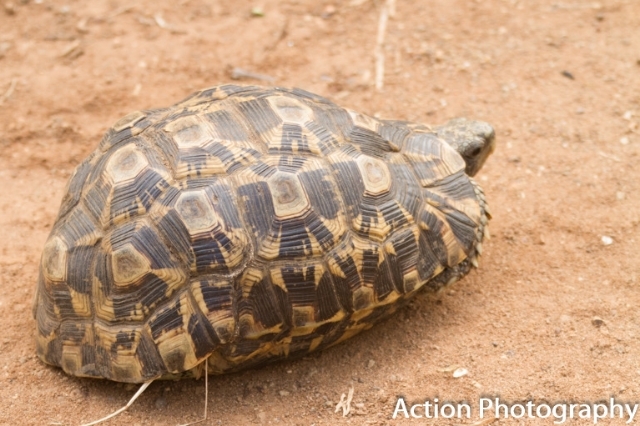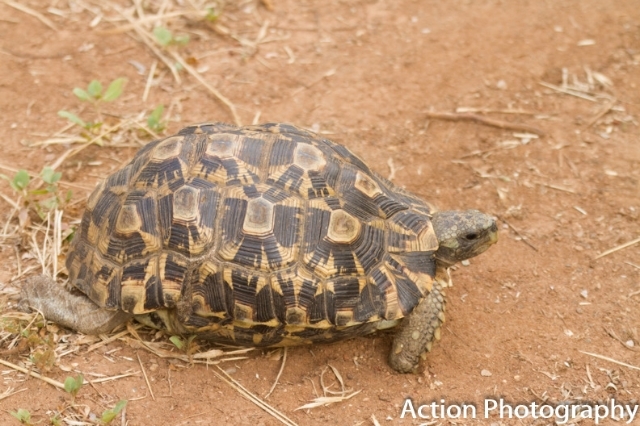Geometric Tortoise Psammobates geometricus
Family: Testudinidae
© Okie
© Okie
Conservation status
IUCN:
Psammobates geometricus is assessed as
Critically Endangered based on known past and projected future population reductions, which combined amount to > 90%, over three generations (90 years). Population decline is due primarily to anthropogenic land transformation, where the causes of destruction have not ceased, based on direct observation, a decline in area of occupancy, extent of occurrence and habitat quality, the effects of introduced feral pigs and other subsidized predators, and unintentional but severe mortality from wildfires affecting small residual subpopulations in limited habitat patches. New threats to the species involve an increasing switch from sheep to cattle farming (greater trampling and habitat degradation); improper land management resulting in dense invasive vegetation that is unsuitable for tortoises; and climate change with an associated increase in drought frequency that intensifies physiological stress on the tortoises and the occurrences of wildfires. In addition, though currently not a major threat, there is the potential for rising levels of exploitation.
NEMBA Status: Endangered
CITES Listing: Appendix I
Description
The convex-shaped shell of the geometric tortoise has a bright yellow starred pattern on a black background and a similar, but duller, less-defined pattern on the underside. It is superficially very similar to the more common and widespread tent tortoise but differs from it in that, in the geometric tortoise, the marginal shields are higher than they are wide and there are no buttock tubercles on the back of the hind legs. The front legs are covered with unequal-sized scales and the front feet have five toes. The hind feet have four toes.
Size
Size: 8-12 cm total length (max: 14.5cm). Weight: 207-436g. There is a marked size difference between males (average 100 mm) and females (average 125 mm).
Geographic distribution
Psammobates geometricus is endemic to the Western Cape, South Africa. Historically, the species occurred from around Eendekuil and Piketberg in the north, southwards through the Swartland (Porterville, Hermon, Wellington, Paarl) to the Strand-Gordon's Bay area in the south, and eastwards in the Upper Breede River Valley, from Tulbagh in the north to just west of Worcester. It was also found in the Ceres Valley, in the northeast. The range currently occupied has diminished markedly, but isolated subpopulations are still found in the Paarl district, north of Wellington towards Porterville, between Tulbagh, Wolseley, and Worcester, and in the Ceres Valley.
Habitat
The geometric tortoise occurs only in the low-lying renosterveld shrublands of the Swartland, Upper Breede River Valley and Ceres Valley, where wheat and wine farming, as well as urban development, have led to the destruction of more than 90% of its habitat. The acidic, nutrient-poor soils support a low shrub vegetation including restios, geophytes and grasses. Typical geometric tortoise habitat comprises shale renosterveld and alluvium fynbos vegetation types.
Behaviour
This tortoise will shelter under vegetation when it is too hot or too cold. It is a very shy tortoise and when encountered, will immediately retract into its shell or scramble for the nearest shelter under vegetation.
Diet
These tortoises feed on small succulents, herbs and grasses.
Reproduction
Sexual maturity is reached at approximately 10 years and females lay one or more clutches of about 1-5 eggs in spring to early summer. The eggs generally hatch after the first winter rains when the ground has softened and fresh young annual plants have appeared, providing food and shelter for the hatchlings. By this time, the fire hazard has also dropped considerably.

- Psammobates geometricus.jpg (71.05 KiB) Viewed 2774 times
Links:
The Conservation Biology of Tortoises. Edited by Ian R. Swingland and Michael W. Klemens. IUCN/SSC Tortoise and Freshwater Turtle Specialist Group
https://www.capenature.co.za/fauna-and- ... -tortoise/
https://www.iucnredlist.org/species/18398/111553007
https://www.farmersweekly.co.za/animals ... -tortoise/
http://biodiversityadvisor.sanbi.org/wp ... tricus.htm
https://books.google.de/books?id=HA9bDw ... se&f=false
 © RogerFraser
© RogerFraser © RogerFraser
© RogerFraser

